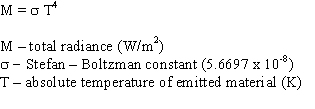Electromagnetic Radiation
Electromagnetic Radiation is the streams of mass-less particles, traveling in a harmonic, sinusoidal fusion at the velocity of light each possessing a specific amount of energy. The distance from one peak to the next is the wavelength and the number of peaks passing through a fixed point per unit time is the wave frequency (Lillesand and Kiefer, 1994). Electromagnetic radiation is Electromagnetic energy in motion and can be described by the basic wave theory.
Basic Wave Theory

wavelength and frequency are inversly proportional.

www.gi.alaska.edu/~prakash/teaching/undergraduate/material/lecture2
Electromagnetic Spectrum
Electromagnetic waves are characterized by their wavelength location within the electromagnetic spectrum which is most commonly measured in micrometers. Names are often assigned to regions of the electromagnetic spectrum, but there is no clear cut dividing lines from one region to the next (Lillesand and Kiefer, 1994).

wwwchem.uwimona.edu.jm:11041spectralunknowns/
Stefan - Boltzmann Law
How much energy any objects radiates is a function of its surface temperature.

The Stefan - Boltzmann equations tells one that as a temperature of a body increase the total radiance of the body will also increase. (Sabins, 1997).